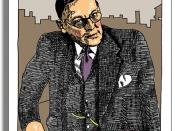Thomas Stearns Eliot, more commonly known as T. S. Eliot, was born September 26, 1888 in Saint Louis Missouri. He was considered to be one of the great leader's in the modernist movement in poetry during the 1920's thru the end of the century. Some of his modern techniques can be seen in works such as The Waste Land, The Four Quartets, and The Love Song of J. Alfred Prufrock. His use of diction, style and way of putting together verses brought new life to the world of poetry. He shattered old orthodoxies and created his own new ones in his critical essays.
Born into a prominent New England Family, Eliot was given the best education possible in schools such as Smith Academy, Milton, and Harvard. He received his Bachelors in Arts after three years, instead of the usual four. As a part of the literary high group at Harvard he received influences from men such as: George Santayana, Irving Babbitt, Charles Baudelaire, Arthur Rimbaud and Jules Laforgue. Eliot used their corporeal yet precise attention to symbolic images, a feature that would be his calling card for his modern approach. Jules Laforgue's influence is present in many of Eliot's poems. Like Laforgue, Eliot uses dialogue between men and women that doesn't seem to communicate anything. Other author's had an influence on Eliot as well, like Henry James and Joseph Conrad. All of these poets had the common themes of separation from people and the world and feelings of isolation, including Eliot. His education at Harvard broadened his horizons with interesting studies such as Indian philosophy and Sanskrit. This could also be the reasons why he slips into foreign tongue in so many of his poems.
For some readers Eliot's poem are difficult because of his style.


